Change Management: Implementing Innovation and Organizational Changes
VerifiedAdded on 2023/06/05
|11
|3240
|352
Report
AI Summary
This report provides a comprehensive analysis of change management, focusing on models, risk assessment, and innovation strategies within business organizations. It examines two options for a manufacturing company aiming to double its production: hiring new employees versus automating processes. The report evaluates the risks associated with each option, including recruitment challenges, potential misplacements, increased managerial needs, decreased versatility, and pollution concerns. It proposes a business risk management plan to mitigate these risks, emphasizing the importance of employee communication, long-term investment strategies, and careful product selection for automation. The report also outlines a strategic process for driving innovation, implementing change management plans, and developing/maintaining relationships with external stakeholders to ensure a smooth transition and sustained organizational growth. The study uses change management models like Lewin’s, McKinsey’s 7-S, Kotter’s 8-Step, and Bridge's Transition Model to facilitate this change.
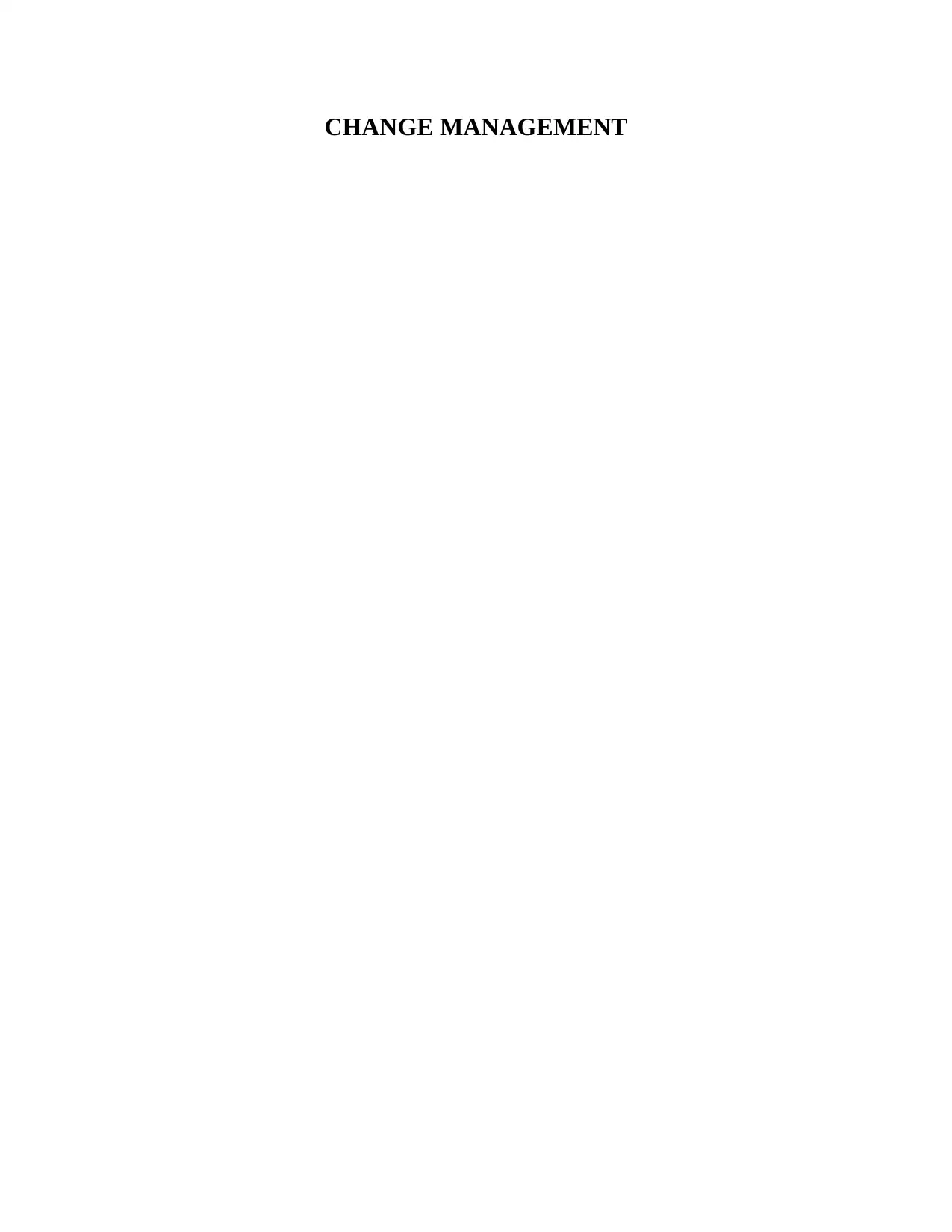
CHANGE MANAGEMENT
Paraphrase This Document
Need a fresh take? Get an instant paraphrase of this document with our AI Paraphraser
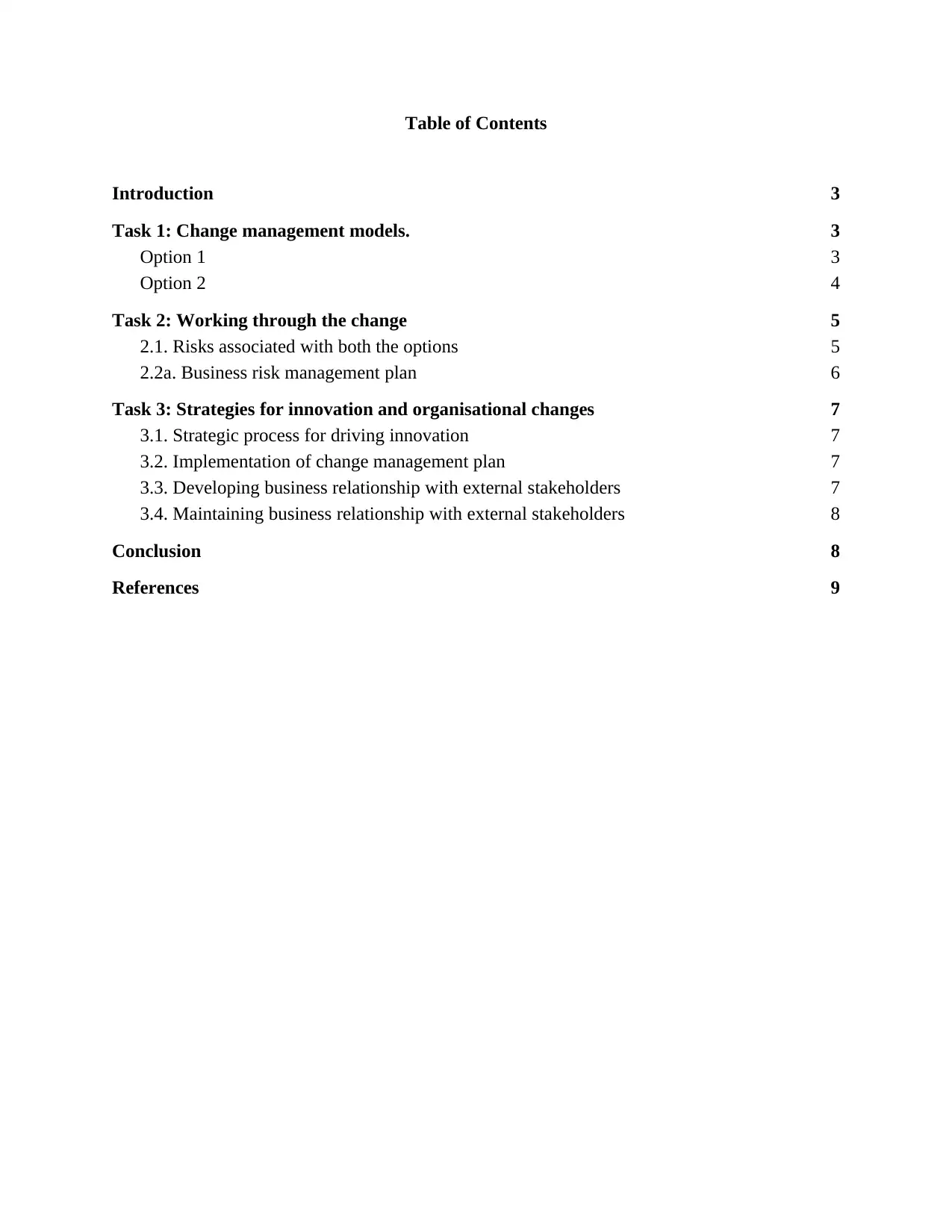
Table of Contents
Introduction 3
Task 1: Change management models. 3
Option 1 3
Option 2 4
Task 2: Working through the change 5
2.1. Risks associated with both the options 5
2.2a. Business risk management plan 6
Task 3: Strategies for innovation and organisational changes 7
3.1. Strategic process for driving innovation 7
3.2. Implementation of change management plan 7
3.3. Developing business relationship with external stakeholders 7
3.4. Maintaining business relationship with external stakeholders 8
Conclusion 8
References 9
Introduction 3
Task 1: Change management models. 3
Option 1 3
Option 2 4
Task 2: Working through the change 5
2.1. Risks associated with both the options 5
2.2a. Business risk management plan 6
Task 3: Strategies for innovation and organisational changes 7
3.1. Strategic process for driving innovation 7
3.2. Implementation of change management plan 7
3.3. Developing business relationship with external stakeholders 7
3.4. Maintaining business relationship with external stakeholders 8
Conclusion 8
References 9
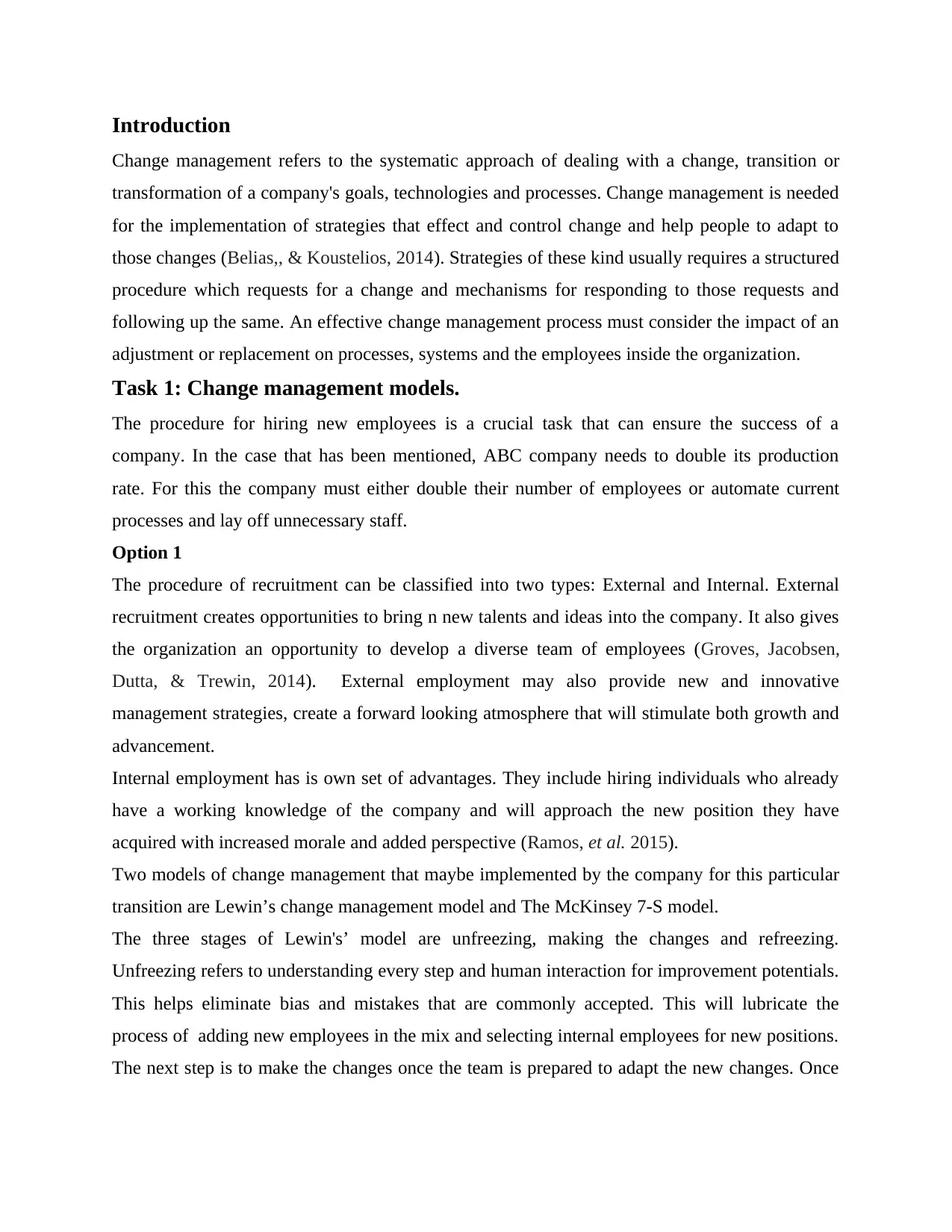
Introduction
Change management refers to the systematic approach of dealing with a change, transition or
transformation of a company's goals, technologies and processes. Change management is needed
for the implementation of strategies that effect and control change and help people to adapt to
those changes (Belias,, & Koustelios, 2014). Strategies of these kind usually requires a structured
procedure which requests for a change and mechanisms for responding to those requests and
following up the same. An effective change management process must consider the impact of an
adjustment or replacement on processes, systems and the employees inside the organization.
Task 1: Change management models.
The procedure for hiring new employees is a crucial task that can ensure the success of a
company. In the case that has been mentioned, ABC company needs to double its production
rate. For this the company must either double their number of employees or automate current
processes and lay off unnecessary staff.
Option 1
The procedure of recruitment can be classified into two types: External and Internal. External
recruitment creates opportunities to bring n new talents and ideas into the company. It also gives
the organization an opportunity to develop a diverse team of employees (Groves, Jacobsen,
Dutta, & Trewin, 2014). External employment may also provide new and innovative
management strategies, create a forward looking atmosphere that will stimulate both growth and
advancement.
Internal employment has is own set of advantages. They include hiring individuals who already
have a working knowledge of the company and will approach the new position they have
acquired with increased morale and added perspective (Ramos, et al. 2015).
Two models of change management that maybe implemented by the company for this particular
transition are Lewin’s change management model and The McKinsey 7-S model.
The three stages of Lewin's’ model are unfreezing, making the changes and refreezing.
Unfreezing refers to understanding every step and human interaction for improvement potentials.
This helps eliminate bias and mistakes that are commonly accepted. This will lubricate the
process of adding new employees in the mix and selecting internal employees for new positions.
The next step is to make the changes once the team is prepared to adapt the new changes. Once
Change management refers to the systematic approach of dealing with a change, transition or
transformation of a company's goals, technologies and processes. Change management is needed
for the implementation of strategies that effect and control change and help people to adapt to
those changes (Belias,, & Koustelios, 2014). Strategies of these kind usually requires a structured
procedure which requests for a change and mechanisms for responding to those requests and
following up the same. An effective change management process must consider the impact of an
adjustment or replacement on processes, systems and the employees inside the organization.
Task 1: Change management models.
The procedure for hiring new employees is a crucial task that can ensure the success of a
company. In the case that has been mentioned, ABC company needs to double its production
rate. For this the company must either double their number of employees or automate current
processes and lay off unnecessary staff.
Option 1
The procedure of recruitment can be classified into two types: External and Internal. External
recruitment creates opportunities to bring n new talents and ideas into the company. It also gives
the organization an opportunity to develop a diverse team of employees (Groves, Jacobsen,
Dutta, & Trewin, 2014). External employment may also provide new and innovative
management strategies, create a forward looking atmosphere that will stimulate both growth and
advancement.
Internal employment has is own set of advantages. They include hiring individuals who already
have a working knowledge of the company and will approach the new position they have
acquired with increased morale and added perspective (Ramos, et al. 2015).
Two models of change management that maybe implemented by the company for this particular
transition are Lewin’s change management model and The McKinsey 7-S model.
The three stages of Lewin's’ model are unfreezing, making the changes and refreezing.
Unfreezing refers to understanding every step and human interaction for improvement potentials.
This helps eliminate bias and mistakes that are commonly accepted. This will lubricate the
process of adding new employees in the mix and selecting internal employees for new positions.
The next step is to make the changes once the team is prepared to adapt the new changes. Once
⊘ This is a preview!⊘
Do you want full access?
Subscribe today to unlock all pages.

Trusted by 1+ million students worldwide
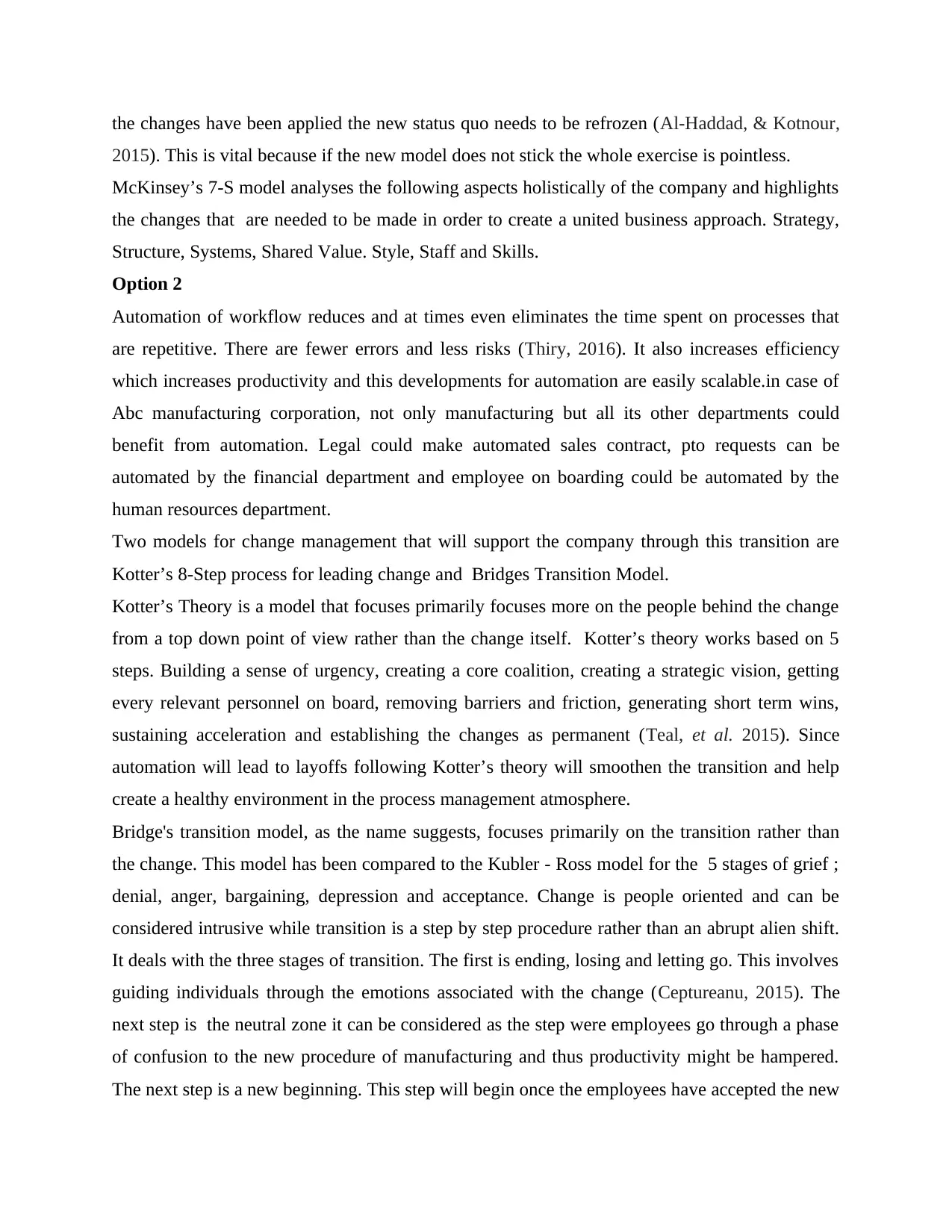
the changes have been applied the new status quo needs to be refrozen (Al-Haddad, & Kotnour,
2015). This is vital because if the new model does not stick the whole exercise is pointless.
McKinsey’s 7-S model analyses the following aspects holistically of the company and highlights
the changes that are needed to be made in order to create a united business approach. Strategy,
Structure, Systems, Shared Value. Style, Staff and Skills.
Option 2
Automation of workflow reduces and at times even eliminates the time spent on processes that
are repetitive. There are fewer errors and less risks (Thiry, 2016). It also increases efficiency
which increases productivity and this developments for automation are easily scalable.in case of
Abc manufacturing corporation, not only manufacturing but all its other departments could
benefit from automation. Legal could make automated sales contract, pto requests can be
automated by the financial department and employee on boarding could be automated by the
human resources department.
Two models for change management that will support the company through this transition are
Kotter’s 8-Step process for leading change and Bridges Transition Model.
Kotter’s Theory is a model that focuses primarily focuses more on the people behind the change
from a top down point of view rather than the change itself. Kotter’s theory works based on 5
steps. Building a sense of urgency, creating a core coalition, creating a strategic vision, getting
every relevant personnel on board, removing barriers and friction, generating short term wins,
sustaining acceleration and establishing the changes as permanent (Teal, et al. 2015). Since
automation will lead to layoffs following Kotter’s theory will smoothen the transition and help
create a healthy environment in the process management atmosphere.
Bridge's transition model, as the name suggests, focuses primarily on the transition rather than
the change. This model has been compared to the Kubler - Ross model for the 5 stages of grief ;
denial, anger, bargaining, depression and acceptance. Change is people oriented and can be
considered intrusive while transition is a step by step procedure rather than an abrupt alien shift.
It deals with the three stages of transition. The first is ending, losing and letting go. This involves
guiding individuals through the emotions associated with the change (Ceptureanu, 2015). The
next step is the neutral zone it can be considered as the step were employees go through a phase
of confusion to the new procedure of manufacturing and thus productivity might be hampered.
The next step is a new beginning. This step will begin once the employees have accepted the new
2015). This is vital because if the new model does not stick the whole exercise is pointless.
McKinsey’s 7-S model analyses the following aspects holistically of the company and highlights
the changes that are needed to be made in order to create a united business approach. Strategy,
Structure, Systems, Shared Value. Style, Staff and Skills.
Option 2
Automation of workflow reduces and at times even eliminates the time spent on processes that
are repetitive. There are fewer errors and less risks (Thiry, 2016). It also increases efficiency
which increases productivity and this developments for automation are easily scalable.in case of
Abc manufacturing corporation, not only manufacturing but all its other departments could
benefit from automation. Legal could make automated sales contract, pto requests can be
automated by the financial department and employee on boarding could be automated by the
human resources department.
Two models for change management that will support the company through this transition are
Kotter’s 8-Step process for leading change and Bridges Transition Model.
Kotter’s Theory is a model that focuses primarily focuses more on the people behind the change
from a top down point of view rather than the change itself. Kotter’s theory works based on 5
steps. Building a sense of urgency, creating a core coalition, creating a strategic vision, getting
every relevant personnel on board, removing barriers and friction, generating short term wins,
sustaining acceleration and establishing the changes as permanent (Teal, et al. 2015). Since
automation will lead to layoffs following Kotter’s theory will smoothen the transition and help
create a healthy environment in the process management atmosphere.
Bridge's transition model, as the name suggests, focuses primarily on the transition rather than
the change. This model has been compared to the Kubler - Ross model for the 5 stages of grief ;
denial, anger, bargaining, depression and acceptance. Change is people oriented and can be
considered intrusive while transition is a step by step procedure rather than an abrupt alien shift.
It deals with the three stages of transition. The first is ending, losing and letting go. This involves
guiding individuals through the emotions associated with the change (Ceptureanu, 2015). The
next step is the neutral zone it can be considered as the step were employees go through a phase
of confusion to the new procedure of manufacturing and thus productivity might be hampered.
The next step is a new beginning. This step will begin once the employees have accepted the new
Paraphrase This Document
Need a fresh take? Get an instant paraphrase of this document with our AI Paraphraser
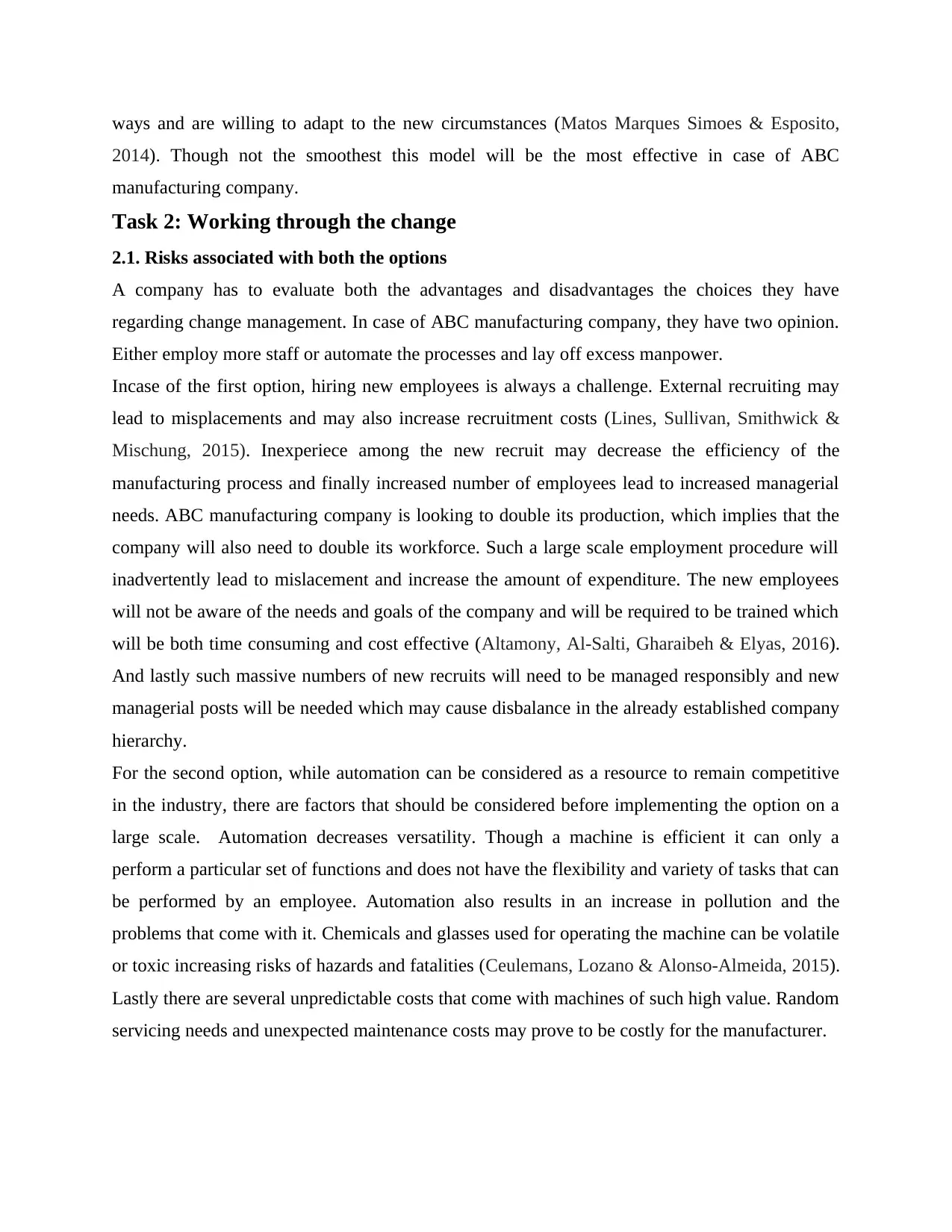
ways and are willing to adapt to the new circumstances (Matos Marques Simoes & Esposito,
2014). Though not the smoothest this model will be the most effective in case of ABC
manufacturing company.
Task 2: Working through the change
2.1. Risks associated with both the options
A company has to evaluate both the advantages and disadvantages the choices they have
regarding change management. In case of ABC manufacturing company, they have two opinion.
Either employ more staff or automate the processes and lay off excess manpower.
Incase of the first option, hiring new employees is always a challenge. External recruiting may
lead to misplacements and may also increase recruitment costs (Lines, Sullivan, Smithwick &
Mischung, 2015). Inexperiece among the new recruit may decrease the efficiency of the
manufacturing process and finally increased number of employees lead to increased managerial
needs. ABC manufacturing company is looking to double its production, which implies that the
company will also need to double its workforce. Such a large scale employment procedure will
inadvertently lead to mislacement and increase the amount of expenditure. The new employees
will not be aware of the needs and goals of the company and will be required to be trained which
will be both time consuming and cost effective (Altamony, Al-Salti, Gharaibeh & Elyas, 2016).
And lastly such massive numbers of new recruits will need to be managed responsibly and new
managerial posts will be needed which may cause disbalance in the already established company
hierarchy.
For the second option, while automation can be considered as a resource to remain competitive
in the industry, there are factors that should be considered before implementing the option on a
large scale. Automation decreases versatility. Though a machine is efficient it can only a
perform a particular set of functions and does not have the flexibility and variety of tasks that can
be performed by an employee. Automation also results in an increase in pollution and the
problems that come with it. Chemicals and glasses used for operating the machine can be volatile
or toxic increasing risks of hazards and fatalities (Ceulemans, Lozano & Alonso-Almeida, 2015).
Lastly there are several unpredictable costs that come with machines of such high value. Random
servicing needs and unexpected maintenance costs may prove to be costly for the manufacturer.
2014). Though not the smoothest this model will be the most effective in case of ABC
manufacturing company.
Task 2: Working through the change
2.1. Risks associated with both the options
A company has to evaluate both the advantages and disadvantages the choices they have
regarding change management. In case of ABC manufacturing company, they have two opinion.
Either employ more staff or automate the processes and lay off excess manpower.
Incase of the first option, hiring new employees is always a challenge. External recruiting may
lead to misplacements and may also increase recruitment costs (Lines, Sullivan, Smithwick &
Mischung, 2015). Inexperiece among the new recruit may decrease the efficiency of the
manufacturing process and finally increased number of employees lead to increased managerial
needs. ABC manufacturing company is looking to double its production, which implies that the
company will also need to double its workforce. Such a large scale employment procedure will
inadvertently lead to mislacement and increase the amount of expenditure. The new employees
will not be aware of the needs and goals of the company and will be required to be trained which
will be both time consuming and cost effective (Altamony, Al-Salti, Gharaibeh & Elyas, 2016).
And lastly such massive numbers of new recruits will need to be managed responsibly and new
managerial posts will be needed which may cause disbalance in the already established company
hierarchy.
For the second option, while automation can be considered as a resource to remain competitive
in the industry, there are factors that should be considered before implementing the option on a
large scale. Automation decreases versatility. Though a machine is efficient it can only a
perform a particular set of functions and does not have the flexibility and variety of tasks that can
be performed by an employee. Automation also results in an increase in pollution and the
problems that come with it. Chemicals and glasses used for operating the machine can be volatile
or toxic increasing risks of hazards and fatalities (Ceulemans, Lozano & Alonso-Almeida, 2015).
Lastly there are several unpredictable costs that come with machines of such high value. Random
servicing needs and unexpected maintenance costs may prove to be costly for the manufacturer.

2.2a. Business risk management plan
Depending on the circumstances, automation may or may not fit a certain business scenario. For
small scale operations that have low quantities of production, the high initial costs of automation
may not be economical but in case of ABC manufacturing the change in production rates will
double. Thus with a larger facility that will need to produce a larger number of heavyweight
products like rods, automation is the only sensible process that will suit the needs of the
company (Van der Voet, 2014). The risks that come with this solution can be mitigated if a few
procedures of solvency are brought into play by the company. Automation can be disruptive and
lead to employee lay off. This may create discord among the remaining workforce and
production may be hampered. To tackle this scenario the management must ensure the workforce
about the long term prospects of automation. Automation will lead to more efficiency which in
the long run will enable the company to undertake larger projects in the future and make it
prosper. This will give the company an opportunity to generate new jobs. Though circumstances
will seem bleak at the beginning but the suggested business models will help the company to
cope up with the scenario. With automation comes a high cost of investment in heavy machinery,
especially in this case. Though this factor will be contrasted to the benefits and cost effectiveness
and compliance of the future the company must be prepared to face additional costs that they
may incur due to unpredictable service and maintenance costs (Cummings Bridgman & Brown,
2016). One simple solution to this problem is to insure the machinery over a long period of time
so as to avoid heavy one time expenditure if they fail in the future. Lastly, automation modifies
workflows. Once automated the tasks and processes of the manufacturing processes become
somewhat rigid. Thus an intelligent choice of products for automation need to be made. A close
look must be take at the versatility and scalability in relativity to the transformation that
company will undergo in the future due to this change.
Depending on the circumstances, automation may or may not fit a certain business scenario. For
small scale operations that have low quantities of production, the high initial costs of automation
may not be economical but in case of ABC manufacturing the change in production rates will
double. Thus with a larger facility that will need to produce a larger number of heavyweight
products like rods, automation is the only sensible process that will suit the needs of the
company (Van der Voet, 2014). The risks that come with this solution can be mitigated if a few
procedures of solvency are brought into play by the company. Automation can be disruptive and
lead to employee lay off. This may create discord among the remaining workforce and
production may be hampered. To tackle this scenario the management must ensure the workforce
about the long term prospects of automation. Automation will lead to more efficiency which in
the long run will enable the company to undertake larger projects in the future and make it
prosper. This will give the company an opportunity to generate new jobs. Though circumstances
will seem bleak at the beginning but the suggested business models will help the company to
cope up with the scenario. With automation comes a high cost of investment in heavy machinery,
especially in this case. Though this factor will be contrasted to the benefits and cost effectiveness
and compliance of the future the company must be prepared to face additional costs that they
may incur due to unpredictable service and maintenance costs (Cummings Bridgman & Brown,
2016). One simple solution to this problem is to insure the machinery over a long period of time
so as to avoid heavy one time expenditure if they fail in the future. Lastly, automation modifies
workflows. Once automated the tasks and processes of the manufacturing processes become
somewhat rigid. Thus an intelligent choice of products for automation need to be made. A close
look must be take at the versatility and scalability in relativity to the transformation that
company will undergo in the future due to this change.
⊘ This is a preview!⊘
Do you want full access?
Subscribe today to unlock all pages.

Trusted by 1+ million students worldwide
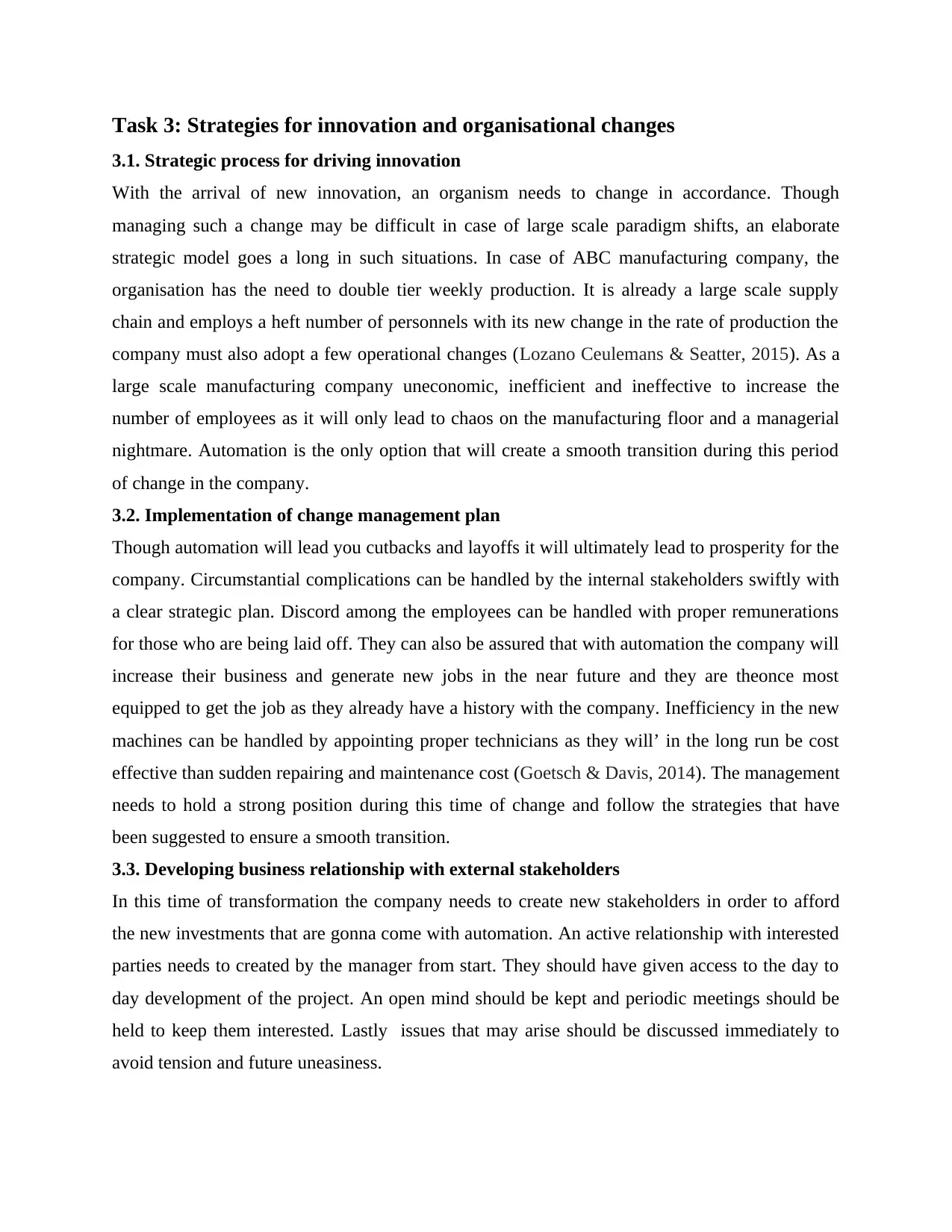
Task 3: Strategies for innovation and organisational changes
3.1. Strategic process for driving innovation
With the arrival of new innovation, an organism needs to change in accordance. Though
managing such a change may be difficult in case of large scale paradigm shifts, an elaborate
strategic model goes a long in such situations. In case of ABC manufacturing company, the
organisation has the need to double tier weekly production. It is already a large scale supply
chain and employs a heft number of personnels with its new change in the rate of production the
company must also adopt a few operational changes (Lozano Ceulemans & Seatter, 2015). As a
large scale manufacturing company uneconomic, inefficient and ineffective to increase the
number of employees as it will only lead to chaos on the manufacturing floor and a managerial
nightmare. Automation is the only option that will create a smooth transition during this period
of change in the company.
3.2. Implementation of change management plan
Though automation will lead you cutbacks and layoffs it will ultimately lead to prosperity for the
company. Circumstantial complications can be handled by the internal stakeholders swiftly with
a clear strategic plan. Discord among the employees can be handled with proper remunerations
for those who are being laid off. They can also be assured that with automation the company will
increase their business and generate new jobs in the near future and they are theonce most
equipped to get the job as they already have a history with the company. Inefficiency in the new
machines can be handled by appointing proper technicians as they will’ in the long run be cost
effective than sudden repairing and maintenance cost (Goetsch & Davis, 2014). The management
needs to hold a strong position during this time of change and follow the strategies that have
been suggested to ensure a smooth transition.
3.3. Developing business relationship with external stakeholders
In this time of transformation the company needs to create new stakeholders in order to afford
the new investments that are gonna come with automation. An active relationship with interested
parties needs to created by the manager from start. They should have given access to the day to
day development of the project. An open mind should be kept and periodic meetings should be
held to keep them interested. Lastly issues that may arise should be discussed immediately to
avoid tension and future uneasiness.
3.1. Strategic process for driving innovation
With the arrival of new innovation, an organism needs to change in accordance. Though
managing such a change may be difficult in case of large scale paradigm shifts, an elaborate
strategic model goes a long in such situations. In case of ABC manufacturing company, the
organisation has the need to double tier weekly production. It is already a large scale supply
chain and employs a heft number of personnels with its new change in the rate of production the
company must also adopt a few operational changes (Lozano Ceulemans & Seatter, 2015). As a
large scale manufacturing company uneconomic, inefficient and ineffective to increase the
number of employees as it will only lead to chaos on the manufacturing floor and a managerial
nightmare. Automation is the only option that will create a smooth transition during this period
of change in the company.
3.2. Implementation of change management plan
Though automation will lead you cutbacks and layoffs it will ultimately lead to prosperity for the
company. Circumstantial complications can be handled by the internal stakeholders swiftly with
a clear strategic plan. Discord among the employees can be handled with proper remunerations
for those who are being laid off. They can also be assured that with automation the company will
increase their business and generate new jobs in the near future and they are theonce most
equipped to get the job as they already have a history with the company. Inefficiency in the new
machines can be handled by appointing proper technicians as they will’ in the long run be cost
effective than sudden repairing and maintenance cost (Goetsch & Davis, 2014). The management
needs to hold a strong position during this time of change and follow the strategies that have
been suggested to ensure a smooth transition.
3.3. Developing business relationship with external stakeholders
In this time of transformation the company needs to create new stakeholders in order to afford
the new investments that are gonna come with automation. An active relationship with interested
parties needs to created by the manager from start. They should have given access to the day to
day development of the project. An open mind should be kept and periodic meetings should be
held to keep them interested. Lastly issues that may arise should be discussed immediately to
avoid tension and future uneasiness.
Paraphrase This Document
Need a fresh take? Get an instant paraphrase of this document with our AI Paraphraser
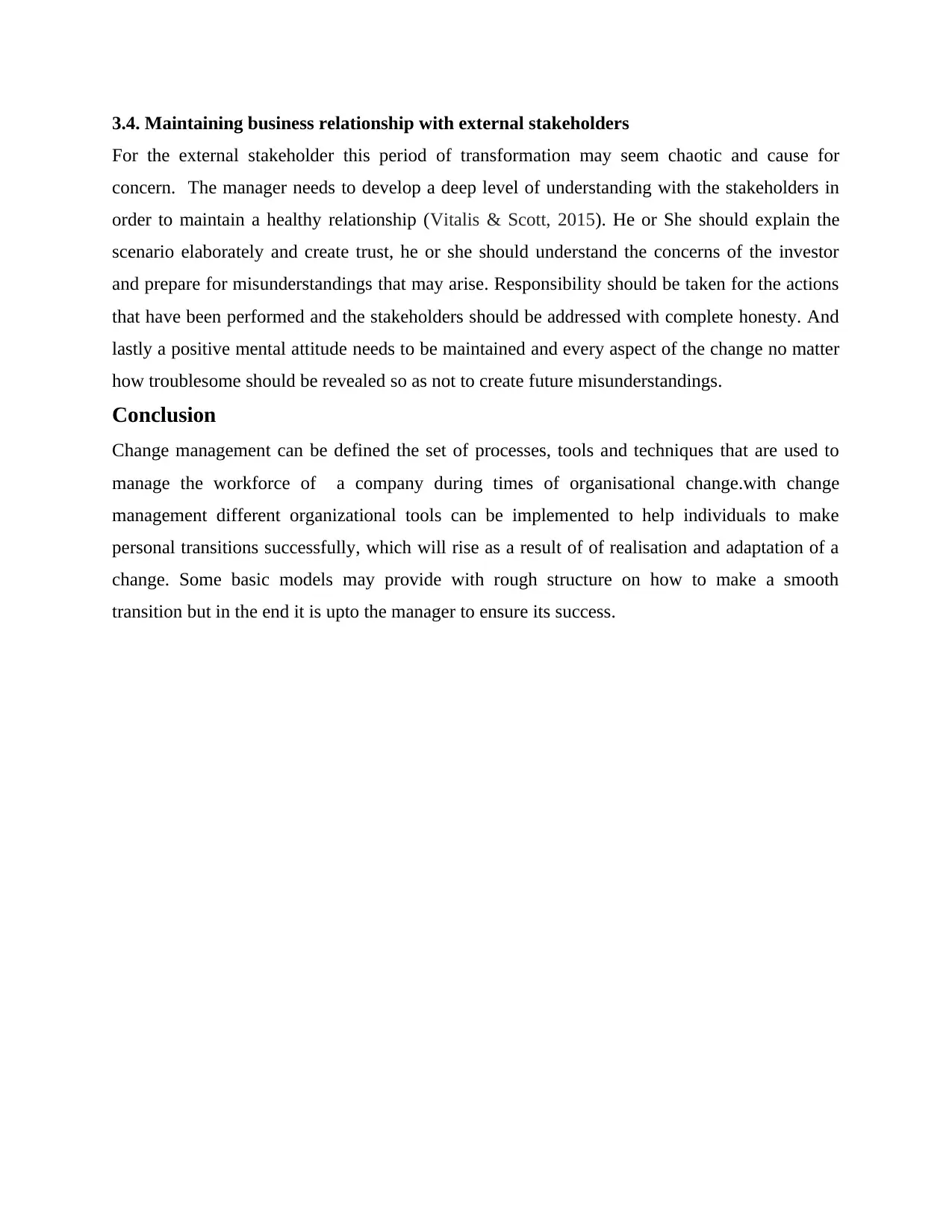
3.4. Maintaining business relationship with external stakeholders
For the external stakeholder this period of transformation may seem chaotic and cause for
concern. The manager needs to develop a deep level of understanding with the stakeholders in
order to maintain a healthy relationship (Vitalis & Scott, 2015). He or She should explain the
scenario elaborately and create trust, he or she should understand the concerns of the investor
and prepare for misunderstandings that may arise. Responsibility should be taken for the actions
that have been performed and the stakeholders should be addressed with complete honesty. And
lastly a positive mental attitude needs to be maintained and every aspect of the change no matter
how troublesome should be revealed so as not to create future misunderstandings.
Conclusion
Change management can be defined the set of processes, tools and techniques that are used to
manage the workforce of a company during times of organisational change.with change
management different organizational tools can be implemented to help individuals to make
personal transitions successfully, which will rise as a result of of realisation and adaptation of a
change. Some basic models may provide with rough structure on how to make a smooth
transition but in the end it is upto the manager to ensure its success.
For the external stakeholder this period of transformation may seem chaotic and cause for
concern. The manager needs to develop a deep level of understanding with the stakeholders in
order to maintain a healthy relationship (Vitalis & Scott, 2015). He or She should explain the
scenario elaborately and create trust, he or she should understand the concerns of the investor
and prepare for misunderstandings that may arise. Responsibility should be taken for the actions
that have been performed and the stakeholders should be addressed with complete honesty. And
lastly a positive mental attitude needs to be maintained and every aspect of the change no matter
how troublesome should be revealed so as not to create future misunderstandings.
Conclusion
Change management can be defined the set of processes, tools and techniques that are used to
manage the workforce of a company during times of organisational change.with change
management different organizational tools can be implemented to help individuals to make
personal transitions successfully, which will rise as a result of of realisation and adaptation of a
change. Some basic models may provide with rough structure on how to make a smooth
transition but in the end it is upto the manager to ensure its success.
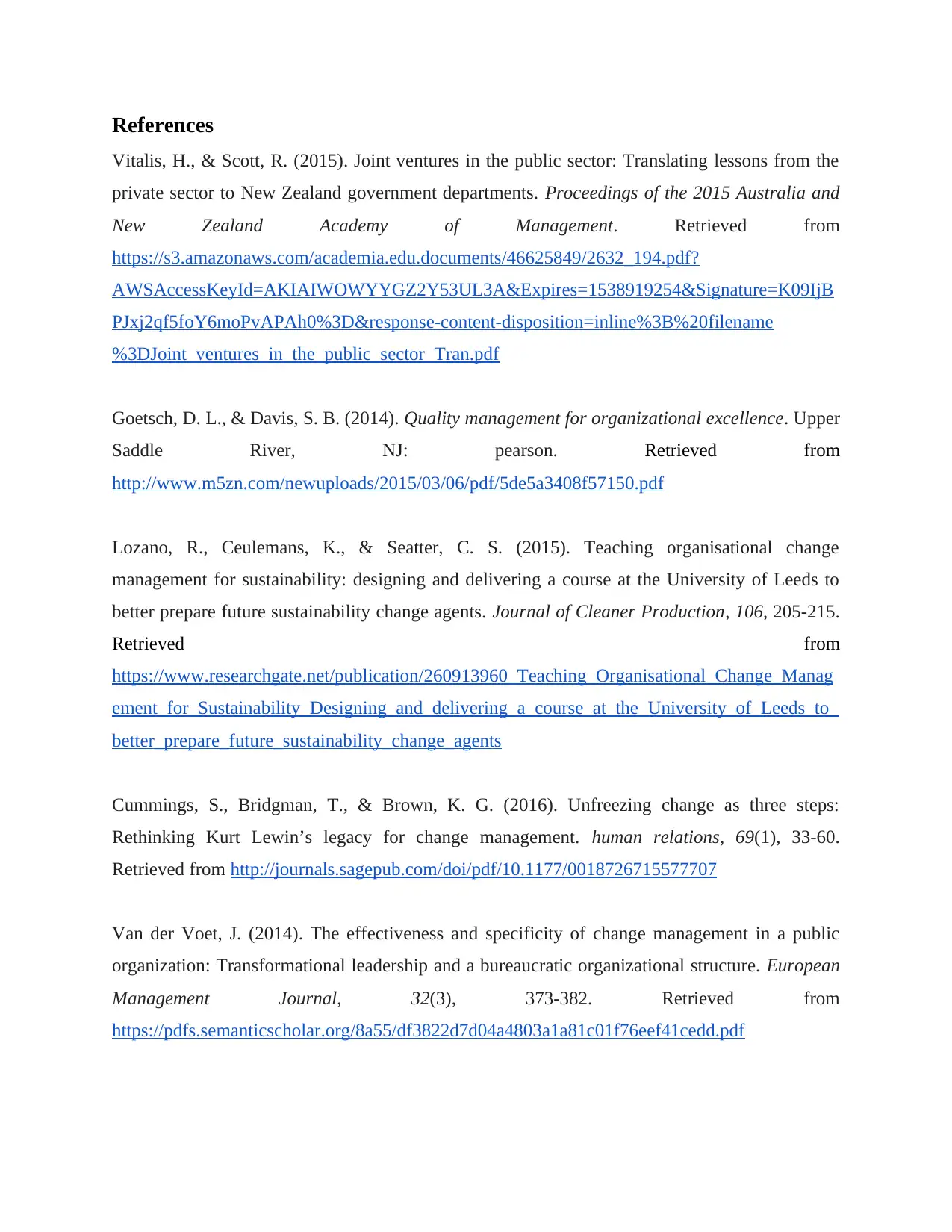
References
Vitalis, H., & Scott, R. (2015). Joint ventures in the public sector: Translating lessons from the
private sector to New Zealand government departments. Proceedings of the 2015 Australia and
New Zealand Academy of Management. Retrieved from
https://s3.amazonaws.com/academia.edu.documents/46625849/2632_194.pdf?
AWSAccessKeyId=AKIAIWOWYYGZ2Y53UL3A&Expires=1538919254&Signature=K09IjB
PJxj2qf5foY6moPvAPAh0%3D&response-content-disposition=inline%3B%20filename
%3DJoint_ventures_in_the_public_sector_Tran.pdf
Goetsch, D. L., & Davis, S. B. (2014). Quality management for organizational excellence. Upper
Saddle River, NJ: pearson. Retrieved from
http://www.m5zn.com/newuploads/2015/03/06/pdf/5de5a3408f57150.pdf
Lozano, R., Ceulemans, K., & Seatter, C. S. (2015). Teaching organisational change
management for sustainability: designing and delivering a course at the University of Leeds to
better prepare future sustainability change agents. Journal of Cleaner Production, 106, 205-215.
Retrieved from
https://www.researchgate.net/publication/260913960_Teaching_Organisational_Change_Manag
ement_for_Sustainability_Designing_and_delivering_a_course_at_the_University_of_Leeds_to_
better_prepare_future_sustainability_change_agents
Cummings, S., Bridgman, T., & Brown, K. G. (2016). Unfreezing change as three steps:
Rethinking Kurt Lewin’s legacy for change management. human relations, 69(1), 33-60.
Retrieved from http://journals.sagepub.com/doi/pdf/10.1177/0018726715577707
Van der Voet, J. (2014). The effectiveness and specificity of change management in a public
organization: Transformational leadership and a bureaucratic organizational structure. European
Management Journal, 32(3), 373-382. Retrieved from
https://pdfs.semanticscholar.org/8a55/df3822d7d04a4803a1a81c01f76eef41cedd.pdf
Vitalis, H., & Scott, R. (2015). Joint ventures in the public sector: Translating lessons from the
private sector to New Zealand government departments. Proceedings of the 2015 Australia and
New Zealand Academy of Management. Retrieved from
https://s3.amazonaws.com/academia.edu.documents/46625849/2632_194.pdf?
AWSAccessKeyId=AKIAIWOWYYGZ2Y53UL3A&Expires=1538919254&Signature=K09IjB
PJxj2qf5foY6moPvAPAh0%3D&response-content-disposition=inline%3B%20filename
%3DJoint_ventures_in_the_public_sector_Tran.pdf
Goetsch, D. L., & Davis, S. B. (2014). Quality management for organizational excellence. Upper
Saddle River, NJ: pearson. Retrieved from
http://www.m5zn.com/newuploads/2015/03/06/pdf/5de5a3408f57150.pdf
Lozano, R., Ceulemans, K., & Seatter, C. S. (2015). Teaching organisational change
management for sustainability: designing and delivering a course at the University of Leeds to
better prepare future sustainability change agents. Journal of Cleaner Production, 106, 205-215.
Retrieved from
https://www.researchgate.net/publication/260913960_Teaching_Organisational_Change_Manag
ement_for_Sustainability_Designing_and_delivering_a_course_at_the_University_of_Leeds_to_
better_prepare_future_sustainability_change_agents
Cummings, S., Bridgman, T., & Brown, K. G. (2016). Unfreezing change as three steps:
Rethinking Kurt Lewin’s legacy for change management. human relations, 69(1), 33-60.
Retrieved from http://journals.sagepub.com/doi/pdf/10.1177/0018726715577707
Van der Voet, J. (2014). The effectiveness and specificity of change management in a public
organization: Transformational leadership and a bureaucratic organizational structure. European
Management Journal, 32(3), 373-382. Retrieved from
https://pdfs.semanticscholar.org/8a55/df3822d7d04a4803a1a81c01f76eef41cedd.pdf
⊘ This is a preview!⊘
Do you want full access?
Subscribe today to unlock all pages.

Trusted by 1+ million students worldwide
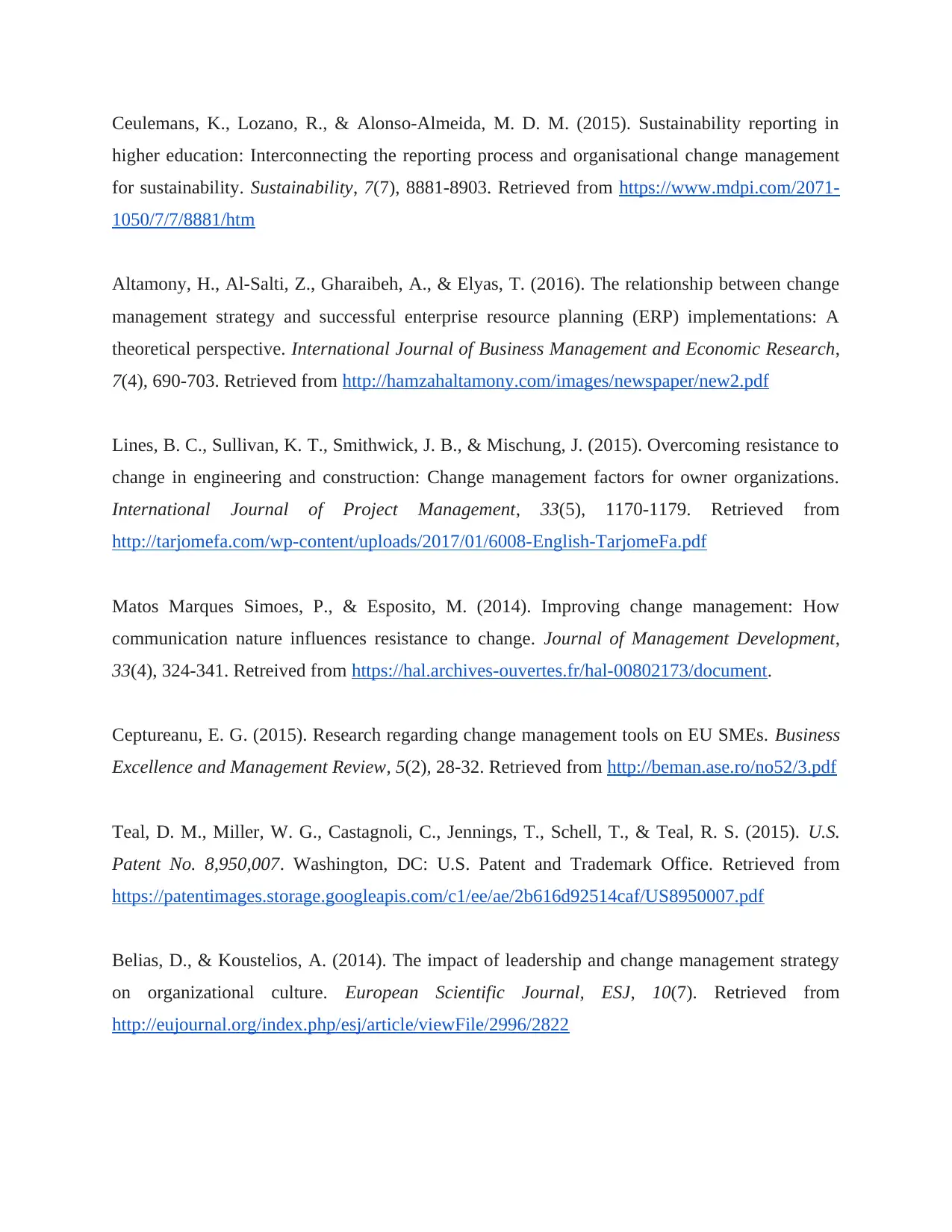
Ceulemans, K., Lozano, R., & Alonso-Almeida, M. D. M. (2015). Sustainability reporting in
higher education: Interconnecting the reporting process and organisational change management
for sustainability. Sustainability, 7(7), 8881-8903. Retrieved from https://www.mdpi.com/2071-
1050/7/7/8881/htm
Altamony, H., Al-Salti, Z., Gharaibeh, A., & Elyas, T. (2016). The relationship between change
management strategy and successful enterprise resource planning (ERP) implementations: A
theoretical perspective. International Journal of Business Management and Economic Research,
7(4), 690-703. Retrieved from http://hamzahaltamony.com/images/newspaper/new2.pdf
Lines, B. C., Sullivan, K. T., Smithwick, J. B., & Mischung, J. (2015). Overcoming resistance to
change in engineering and construction: Change management factors for owner organizations.
International Journal of Project Management, 33(5), 1170-1179. Retrieved from
http://tarjomefa.com/wp-content/uploads/2017/01/6008-English-TarjomeFa.pdf
Matos Marques Simoes, P., & Esposito, M. (2014). Improving change management: How
communication nature influences resistance to change. Journal of Management Development,
33(4), 324-341. Retreived from https://hal.archives-ouvertes.fr/hal-00802173/document.
Ceptureanu, E. G. (2015). Research regarding change management tools on EU SMEs. Business
Excellence and Management Review, 5(2), 28-32. Retrieved from http://beman.ase.ro/no52/3.pdf
Teal, D. M., Miller, W. G., Castagnoli, C., Jennings, T., Schell, T., & Teal, R. S. (2015). U.S.
Patent No. 8,950,007. Washington, DC: U.S. Patent and Trademark Office. Retrieved from
https://patentimages.storage.googleapis.com/c1/ee/ae/2b616d92514caf/US8950007.pdf
Belias, D., & Koustelios, A. (2014). The impact of leadership and change management strategy
on organizational culture. European Scientific Journal, ESJ, 10(7). Retrieved from
http://eujournal.org/index.php/esj/article/viewFile/2996/2822
higher education: Interconnecting the reporting process and organisational change management
for sustainability. Sustainability, 7(7), 8881-8903. Retrieved from https://www.mdpi.com/2071-
1050/7/7/8881/htm
Altamony, H., Al-Salti, Z., Gharaibeh, A., & Elyas, T. (2016). The relationship between change
management strategy and successful enterprise resource planning (ERP) implementations: A
theoretical perspective. International Journal of Business Management and Economic Research,
7(4), 690-703. Retrieved from http://hamzahaltamony.com/images/newspaper/new2.pdf
Lines, B. C., Sullivan, K. T., Smithwick, J. B., & Mischung, J. (2015). Overcoming resistance to
change in engineering and construction: Change management factors for owner organizations.
International Journal of Project Management, 33(5), 1170-1179. Retrieved from
http://tarjomefa.com/wp-content/uploads/2017/01/6008-English-TarjomeFa.pdf
Matos Marques Simoes, P., & Esposito, M. (2014). Improving change management: How
communication nature influences resistance to change. Journal of Management Development,
33(4), 324-341. Retreived from https://hal.archives-ouvertes.fr/hal-00802173/document.
Ceptureanu, E. G. (2015). Research regarding change management tools on EU SMEs. Business
Excellence and Management Review, 5(2), 28-32. Retrieved from http://beman.ase.ro/no52/3.pdf
Teal, D. M., Miller, W. G., Castagnoli, C., Jennings, T., Schell, T., & Teal, R. S. (2015). U.S.
Patent No. 8,950,007. Washington, DC: U.S. Patent and Trademark Office. Retrieved from
https://patentimages.storage.googleapis.com/c1/ee/ae/2b616d92514caf/US8950007.pdf
Belias, D., & Koustelios, A. (2014). The impact of leadership and change management strategy
on organizational culture. European Scientific Journal, ESJ, 10(7). Retrieved from
http://eujournal.org/index.php/esj/article/viewFile/2996/2822
Paraphrase This Document
Need a fresh take? Get an instant paraphrase of this document with our AI Paraphraser

Groves, M., Jacobsen, J., Dutta, S., & Trewin, T. G. (2014). U.S. Patent No. 8,726,226.
Washington, DC: U.S. Patent and Trademark Office. Retrieved from
https://patentimages.storage.googleapis.com/a2/fd/e2/2811e7fc4e333a/US8726226.pdf
Ramos, T. B., Caeiro, S., Van Hoof, B., Lozano, R., Huisingh, D., & Ceulemans, K. (2015).
Experiences from the implementation of sustainable development in higher education
institutions: Environmental management for sustainable universities. Journal of Cleaner
Production, 106, 3-10. Rerieved from
https://www.researchgate.net/publication/278156620_Bridges_for_a_more_sustainable_future_J
oining_Environmental_Management_for_Sustainable_Universities_EMSU_and_the_European_
Roundtable_for_Sustainable_Consumption_and_Production_ERSCP_conferences
Al-Haddad, S., & Kotnour, T. (2015). Integrating the organizational change literature: a model
for successful change. Journal of Organizational Change Management, 28(2), 234-262.
Retrieved from http://www.cin.ufpe.br/~llfj/Emerald/Integrating%20the%20organizational
%20change%20literature%20-%20a%20model%20for%20successful%20change.pdf
Thiry, M. (2016). Program management. Routledge. Retrieved from
http://www.maxwideman.com/papers/program_management/program_management.pdf
Washington, DC: U.S. Patent and Trademark Office. Retrieved from
https://patentimages.storage.googleapis.com/a2/fd/e2/2811e7fc4e333a/US8726226.pdf
Ramos, T. B., Caeiro, S., Van Hoof, B., Lozano, R., Huisingh, D., & Ceulemans, K. (2015).
Experiences from the implementation of sustainable development in higher education
institutions: Environmental management for sustainable universities. Journal of Cleaner
Production, 106, 3-10. Rerieved from
https://www.researchgate.net/publication/278156620_Bridges_for_a_more_sustainable_future_J
oining_Environmental_Management_for_Sustainable_Universities_EMSU_and_the_European_
Roundtable_for_Sustainable_Consumption_and_Production_ERSCP_conferences
Al-Haddad, S., & Kotnour, T. (2015). Integrating the organizational change literature: a model
for successful change. Journal of Organizational Change Management, 28(2), 234-262.
Retrieved from http://www.cin.ufpe.br/~llfj/Emerald/Integrating%20the%20organizational
%20change%20literature%20-%20a%20model%20for%20successful%20change.pdf
Thiry, M. (2016). Program management. Routledge. Retrieved from
http://www.maxwideman.com/papers/program_management/program_management.pdf
1 out of 11
Related Documents
Your All-in-One AI-Powered Toolkit for Academic Success.
+13062052269
info@desklib.com
Available 24*7 on WhatsApp / Email
![[object Object]](/_next/static/media/star-bottom.7253800d.svg)
Unlock your academic potential
Copyright © 2020–2025 A2Z Services. All Rights Reserved. Developed and managed by ZUCOL.





